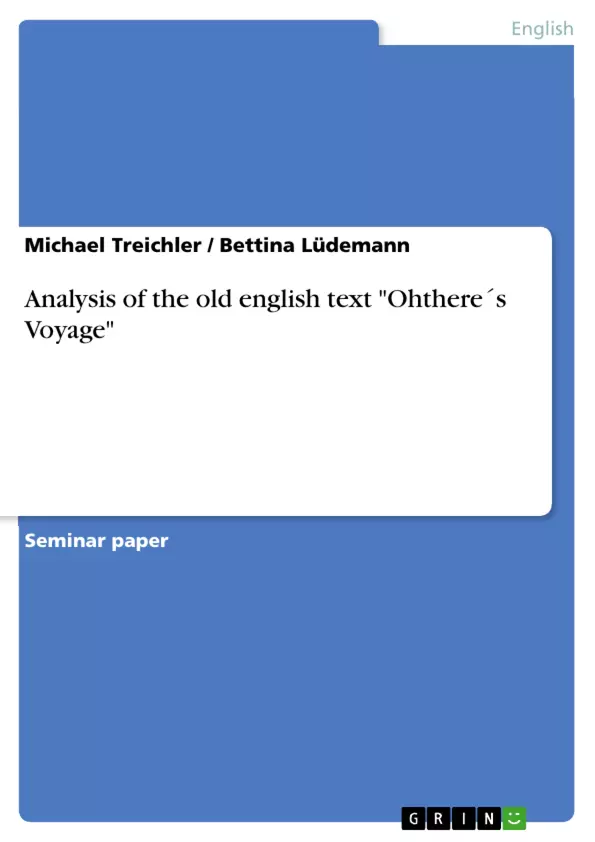The description of Ohthere’s voyages is an insertion into a translation of “A history of the world” by Paulus Orosius. Orosius was a fifth century Spanish cleric, who was engaged by the North African Bishop Augustinus of Hippo to write his Historia adversus paganos (“History against the pagans”) in order to refute pagan claims that the coming of Christianity was responsible for recent disasters in Europe.
Possibly, the Old English Orosius was one of the works of translation commissioned by King Ælfred of Wessex (reign: 871 - 899) as a part of his educational program proclaimed in the preface to Gregory the Great ’s Pastoral Care ( cf. Raith 1958: 1) . Since Orosius’ version only covered the geography south of the Alps, it was lacking the Northern part of Western Europe. Therefore, the narratives of the voyages of Ohthere and Wulfstan, two seafarers, who sailed the Northern and Baltic Sea, were added to complete and extend Orosius` description.
The text of Orosius is divided into six books, which are each further subdivided into sections. The present work will concentrate on the first section of the first book where Ohthere reports to King Alfred about his first journey from his homeland, Halgoland, which today is the province of Hålogaland in Northern Norway, around the Northern Cape to the White Sea (Ekblom 1941/42: 115).
Since most readers will be unfamiliar with the Old English language, a normal translation of the text would not be sufficient to identify its grammatical structure. Therefore, the first part of the following analysis contains an interlinear morphemic translation of the Old English text.
The second part of the analysis starts with an examination of several functions of OE cases found in the text and the differences to their realization in MnE. After a view on OE negations, two common OE syntactical structures will be discussed by examining certain examples occurring in the text.
Inhaltsverzeichnis (Table of Contents)
- Introduction
- The cultural and historical background of the text
- About Ohthere
- The manuscripts
- Analysis of the text
- Interlinear Morphemic Translation
- Abbreviations used
- Interlinear Morphemic Translation
- Analysis of the function of OE cases
- The dative
- The genitive
- The accusative
- Analysis of the OE negations
- Analysis of OE syntactical structures
- Subordinate clauses
- The demonstrative order
- Bibliography
Zielsetzung und Themenschwerpunkte (Objectives and Key Themes)
This paper analyzes the Old English text "Ohthere's Voyage," examining its historical and cultural context, exploring the intricacies of Old English grammar, and providing an interlinear morphemic translation to understand the text's structure.
- The historical and cultural context of "Ohthere's Voyage" and its connection to the broader context of Old English literature.
- An analysis of the grammatical features of Old English, focusing on cases, negations, and syntactic structures.
- A detailed interlinear morphemic translation of the text, revealing its grammatical components and demonstrating the differences between Old English and modern English.
- The role of the "Ohthere's Voyage" text within the larger work of "A history of the world" by Paulus Orosius.
- The significance of the text as a historical and linguistic source for understanding the Anglo-Saxon period.
Zusammenfassung der Kapitel (Chapter Summaries)
The introduction establishes the historical and cultural context of "Ohthere's Voyage" as an insertion within the Old English translation of Orosius's "History against the pagans." It discusses the potential authorship of King Ælfred and the historical significance of the voyage narratives in completing the geographical scope of Orosius's work.
The chapter dedicated to Ohthere provides biographical information and explores his role as a Norse merchant and explorer. It also examines the historical context of the meeting between Ohthere and King Ælfred, highlighting the period of Viking attacks and the establishment of the Danelaw in England.
The section on the manuscripts discusses the different manuscripts containing the Old English Orosius, including their history, current locations, and their significance for the analysis of the text. It highlights the Lauderdale manuscript as the most complete and reliable source for the text.
The chapter titled "Analysis of the text" outlines the structure of the text and the focus on Ohthere's first voyage. It also explains the importance of interlinear morphemic translation for understanding the grammatical structure of Old English.
The chapter dedicated to interlinear morphemic translation begins with a definition of abbreviations used in the analysis, followed by a comprehensive interlinear morphemic translation of the Old English text "Ohthere's Voyage."
Schlüsselwörter (Keywords)
This analysis focuses on the Old English text "Ohthere's Voyage," exploring its historical and cultural context, examining its grammatical features, and providing an interlinear morphemic translation. Key terms and concepts include Old English grammar, interlinear morphemic translation, case system, negation, syntax, historical context, Viking attacks, Danelaw, Anglo-Saxon period, and "A history of the world" by Paulus Orosius.
- Citation du texte
- Michael Treichler (Auteur), Bettina Lüdemann (Auteur), 2002, Analysis of the old english text "Ohthere´s Voyage", Munich, GRIN Verlag, https://www.grin.com/document/5199



